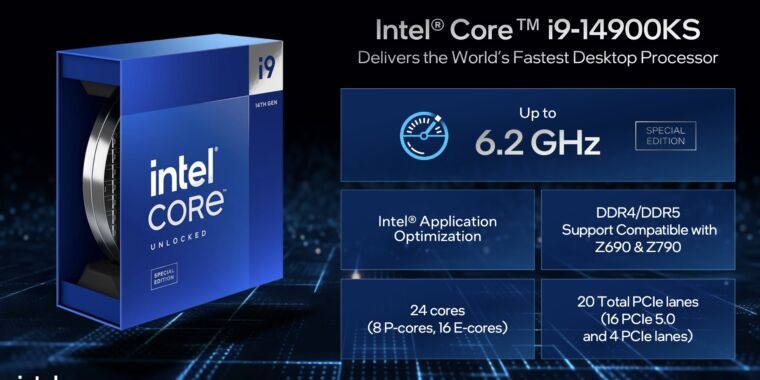This is the best summary I could come up with:
PC enthusiasts who have been around the block a couple of times might remember the stretch from the '90s into the early 2000s when ever-increasing clock speeds were Intel’s primary metric for increasing processor performance.
Today, the company is ever so briefly revisiting those old days with the $689 Core i9-14900KS, its newest flagship desktop processor.
On the one hand, Intel has managed to push clock speeds even higher without changing its architecture or manufacturing process, a culmination of years of iteration across the 12th-, 13th-, and 14th-generation processor families.
On the impractical side, the i9-14900KS can use a ridiculous amount of power to achieve marginally faster performance, reminding us of the laws of physics that helped shut down the megahertz wars in the first place.
Intel’s specs list a special 320 W TDP level for the i9-14900KS, significantly higher than the 253 W TDP for the Core i9-14900K (though manufacturers often ignore Intel’s specs here, allowing CPUs to run with effectively unlimited TDPs and relying on thermal throttling to keep processors from frying themselves).
Never say never—Intel does love to rebrand and reuse old silicon to launch quote-unquote new products—but current rumors suggests that the new LGA 1851 socket and next-gen “Arrow Lake” processors will become Intel’s flagship desktop platform at some point in the next year or so.
The original article contains 433 words, the summary contains 220 words. Saved 49%. I’m a bot and I’m open source!
You don’t crank up the clock speed for massively parallel workloads like rendering in blender. Higher clock speed is for single threaded workloads that need to go faster.
Intel chips were sexy as fuck back in the 90’s. Too bad they couldn’t maintain.
tldr: diminishing returns on performance gain for power consumption
In one Blender rendering benchmark, the i9-14900KS consumed 31 percent more power than the i9-14900K for a less than 1 percent performance gain. The gap isn’t always quite that large, but the power usage increase is generally disproportionate to the performance increase.
it’s even worse when you also look at the 65w versions (which also don’t need elaborate cooling solutions. just a noctua or similar) of the same chip. 14900(f) vs ‘k’ vs ‘ks’






